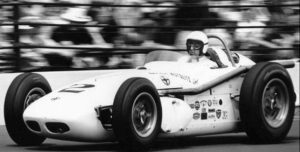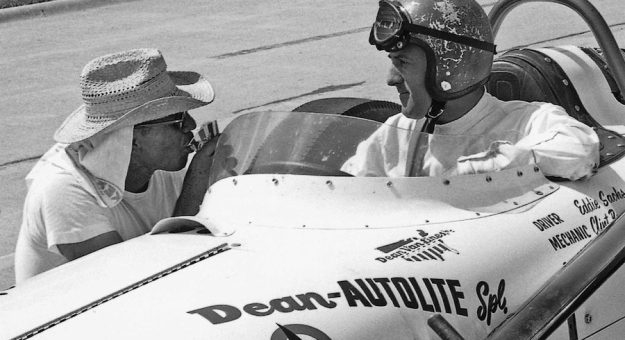Eddie Sachs consistently demonstrated an uncanny ability to find the fast way around Indianapolis Motor Speedway. In five years, he qualified on the front row four times, earning the pole in 1960 and ’61.
As practice began for the 1962 Indianapolis 500, Sachs was considered the odds-on-favorite to be the first to break the 150-mph barrier.
In 1960, Jim Hurtubise came tantalizingly close with a lap at 149.601 mph. Then, before his fatal accident during practice the previous May, Tony Bettenhausen unofficially came within tenths-of-a-second of the speed mark.
Thus, when speedway owner Tony Hulman announced the track would be repaved before the 1962 race, including the rough, all-brick frontstretch, anticipation for the one-minute lap escalated to sensational levels.

And to the media’s glee, the always gregarious Sachs provided headline quotes about being the one to get the job done.
But all was not well within Sachs’ Dean Van Lines team.
Yes, they’d come close to winning the 1961 500. Probably should have. The loss created a bitter rift between Sachs and iconic crew chief Clint Brawner.
Brawner blamed Sachs for the defeat. While leading with three laps to go, Sachs unexpectedly dove into the pits for fresh tires. He believed they were unsafely worn. Brawner didn’t.
“He should’ve chanced it,” insisted Brawner. “Ran clear around on the rim if he had to. If he’d slowed, Foyt couldn’t have caught him. Eddie should’ve known the tires would’ve lasted.”
When Sachs couldn’t get speed from the car in the early practice days of 1962, the rift between he and Brawner, who hadn’t wanted to hire Sachs anyway, widened.
Driving the same Wayne Ewing-built roadster he put on the pole the previous two years, Sachs struggled. He was nowhere close to challenging the 150-mph mark. In fact, he feared he might not even make the race.
Brawner said Sachs was the problem He wasn’t pushing hard enough and was more concerned about his fledging business interests than driving race cars. As might be expected, Sachs placed the onus on Brawner, saying he’d spread himself too thin attempting to get Norm Hall in the team car up to speed.
Sachs could’ve had a point here, as Brawner finally parked the car after Hall crashed it twice.
During Pole Day practice, Sachs’ left-front wheel came off exiting the fourth turn. Sachs was visibly shaken, and livid. Had the wheel departed in the middle of the turn the results could’ve been disastrous.
What little confidence Sachs had left in Brawner evaporated. Although the car suffered only minor damage, it sat in the garage. The following day, more practice, and still no qualification attempt.
Sachs and Brawner were desperate for help and recruited Foyt, who had beaten them in 1961, to shake down their Autolite Special. Foyt could run no faster, so Brawner opted for a new Offy. It provided little improvement. Sachs squeezed into the show in 27th position on the final qualifying weekend.
Come race day, Sachs was ignored as a contender for the win. Maybe that inspired him. Something did. Renowned for his ability to make an ill-handling car fast, Sachs marched to the front.
Passing seven cars in the first two laps, he was up to eighth by the 90th circuit of the 2.5-mile track.
He took the lead briefly before pitting and came out in fourth behind Parnelli Jones, who was credited with breaking the 150-mph milestone during qualifying, Rodger Ward and Roger McCluskey. A series of pit stops positioned him second behind Ward. Sachs eventually finished third.
It was his best drive in the 500. Better than his 1961 second-place run. Despite his lack of confidence in his car and the ongoing feud with his chief mechanic, Sachs clawed past 24 cars to put himself in a position that could’ve brought victory.
Sachs was exuberant afterward until he realized he’d finished 20 seconds behind Ward, while spending 21 seconds longer in the pits. Sachs and Brawner parted ways. Sachs believed his best opportunity to win the 500 would come with another team.
Sadly, Sachs was killed in a crash at the speedway in 1964 in what was his eighth start in the event.
Brawner went to victory lane at Indianapolis with Mario Andretti in 1969.
This story appeared in the Nov 1, 2023 edition of the SPEED SPORT Insider.

